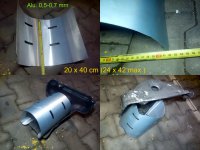Hi Bernie, Are you enjoying everson's cam belt saga? I'm feeling a bit nervous that he's going to manage this? wish one of us was somewhere nearby because he sounds so enthusiastic, just lacking experience I think?
Anyway, regarding the VCDS (or VAG-COM, as it was called when I bought it originally). The main VCDS program is a "reverse engineered" version of the VW tool developed by Ross tech in the states and works on all the VW group vehicles (apparently I could "talk" to a Bentley with it if anyone was foolish enough to let me get that close to one). In their wisdom they also included a generic OBD reader free as part of the deal - it comes up as a selectable option on the first screen when you wake the program up. I've tried it on a number of non VW group vehicles and it's worked just fine. I use it regularly on my boy's Astra for instance. However when I try to connect to our Panda (and I've only tried the once) the poor old girl gets a real "knee trembler" on. The program won't connect properly so you can't interrogate anything and the EPS "growls" alarmingly and sets fault codes. (you don't know about the fault codes until you go in with MES and look for them - luckily MES let me clear them all and she's fine. Don't think I'll be trying it again though!
The whole reason behind this is that I've had a bit of a "wierd" thing going on with the Panda ever since we've owned her. When driving on small throttle openings she's absolutely fine and a dream to drive. On large throttle openings, she doesn't pull cleanly. It's not a missfire, just a "reluctance" to pull strongly. It's as if the mixture isn't quite richening up enough? So far the only really concrete "strange" result I'm aware of is that the post cat O2 sensor is stuck up at .9v However the pre cat one is cycling as it should and at a good speed. The car also passes emissions at it's yearly test. I think this sensor may be a bit of a red herring though as it's the pre cat (upstream) one that really contributes to fuelling. I haven't done any checking of the MAP yet and I suspect this may be at the root of it (just been far to busy with all the other family cars to look at our own). As regards the downstream O2 sensor, could it just fail with a permanent high reading? I doubt it but I just don't know?
Regards, as always
Jock
Anyway, regarding the VCDS (or VAG-COM, as it was called when I bought it originally). The main VCDS program is a "reverse engineered" version of the VW tool developed by Ross tech in the states and works on all the VW group vehicles (apparently I could "talk" to a Bentley with it if anyone was foolish enough to let me get that close to one). In their wisdom they also included a generic OBD reader free as part of the deal - it comes up as a selectable option on the first screen when you wake the program up. I've tried it on a number of non VW group vehicles and it's worked just fine. I use it regularly on my boy's Astra for instance. However when I try to connect to our Panda (and I've only tried the once) the poor old girl gets a real "knee trembler" on. The program won't connect properly so you can't interrogate anything and the EPS "growls" alarmingly and sets fault codes. (you don't know about the fault codes until you go in with MES and look for them - luckily MES let me clear them all and she's fine. Don't think I'll be trying it again though!
The whole reason behind this is that I've had a bit of a "wierd" thing going on with the Panda ever since we've owned her. When driving on small throttle openings she's absolutely fine and a dream to drive. On large throttle openings, she doesn't pull cleanly. It's not a missfire, just a "reluctance" to pull strongly. It's as if the mixture isn't quite richening up enough? So far the only really concrete "strange" result I'm aware of is that the post cat O2 sensor is stuck up at .9v However the pre cat one is cycling as it should and at a good speed. The car also passes emissions at it's yearly test. I think this sensor may be a bit of a red herring though as it's the pre cat (upstream) one that really contributes to fuelling. I haven't done any checking of the MAP yet and I suspect this may be at the root of it (just been far to busy with all the other family cars to look at our own). As regards the downstream O2 sensor, could it just fail with a permanent high reading? I doubt it but I just don't know?
Regards, as always
Jock



